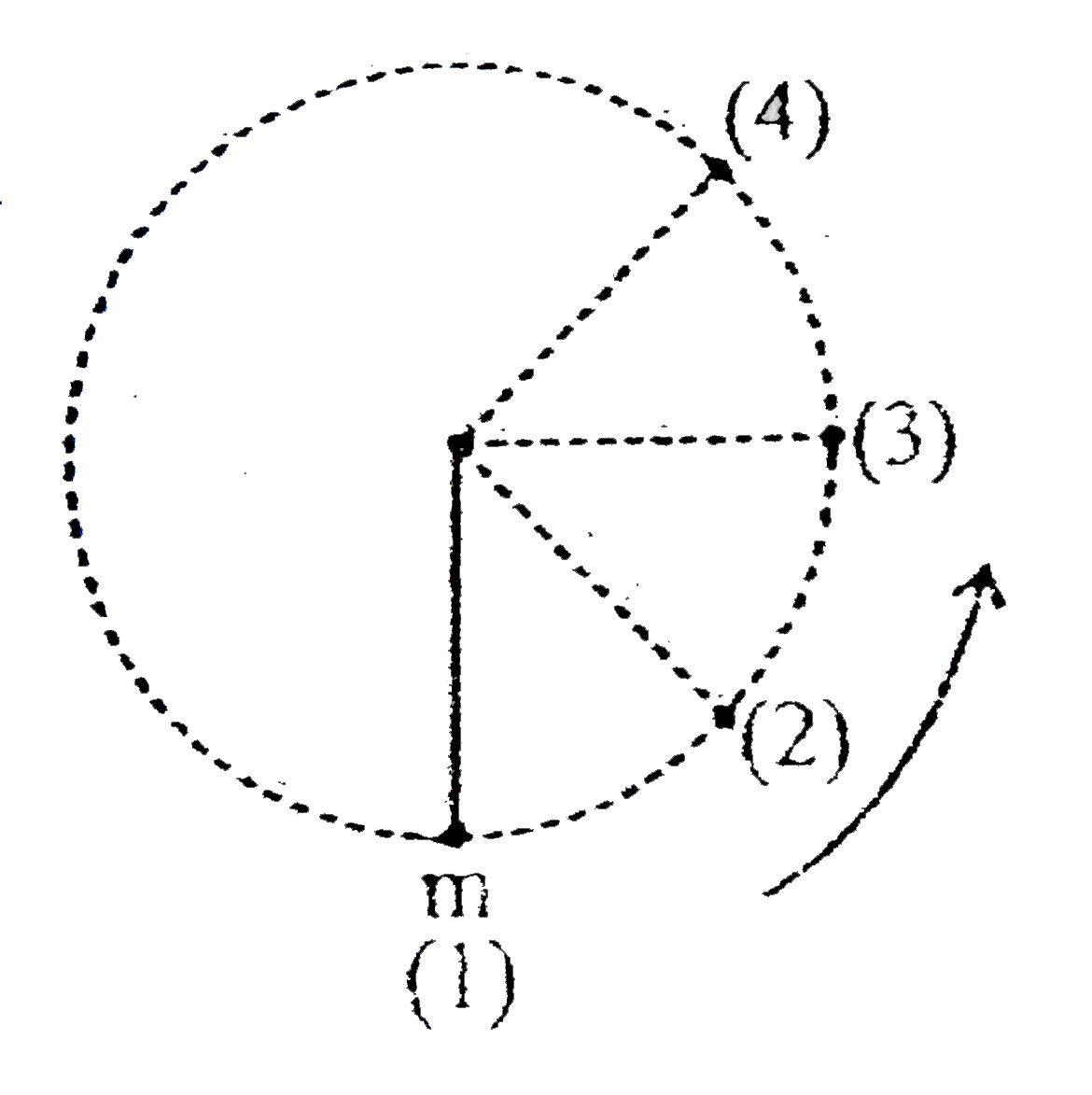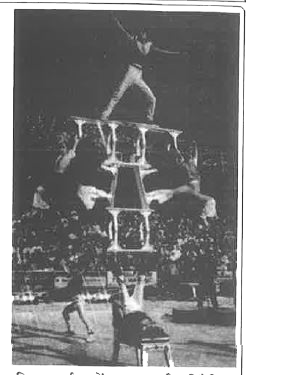In a human pyramid in a circus, the entire weight of the balanced group is supported by the legs of a performer who is lying on his back. The combined mass of all the persons performing the act, and the tables, plaques etc. involved is 280 kg. The mass of the performer lying on his back at the bottom of the pyramid is 60 kg. Each thighbone (femur) of this performer has a length of 50 cm and an effective radius of 2.0 cm. Determine the amount by which each thighbone gets compressed under the extra load. (g=9.8ms−2) Young's Modulus for bone Y=9.4×109Nm−2. Solution in Gujrati
Tota mass of all the performers tables, plaques etc. Is M = 280 kg
Mass of performer at the bottom of the pyramid m=60kg
Mass of supported by the legs of the performer at the bottom of the pyramid m1=M−m
∴m1=280−60=220kg
Weight of this supported mass,
W=m1g=220×9.8=2156N
Weight suppported by each thingbone of the proformer (weight) =W2=21562=1078N(∵ Two thingbone)
Length of each thingbone L=0.5m
The radius of thingbone r=2.0m=2×10−2m
Young.s modulus, Y=F/AΔL/L
∴ΔL=Fπr2×LY
where, ΔL= compression in each thingbone.
=10783.14×(2×10−2)2×0.59.4×109=4.565×10−5m=4.56×10−5m
The fractional decrease in the thingbone,
ΔLL=4.56×10−50.5=9.12×10−5
∴ΔLL×100%9.12×10−3%
Topper's Solved these Questions
- BOOK - KUMAR PRAKASHANCHAPTER - MACHANICAL PROPERTIES OF SOLIDS EXERCISE - SECTION-C66videos
MACHANICAL PROPERTIES OF SOLIDS
- BOOK - KUMAR PRAKASHANCHAPTER - MACHANICAL PROPERTIES OF SOLIDS EXERCISE - SECTION-D29videos
MACHANICAL PROPERTIES OF SOLIDS
- BOOK - KUMAR PRAKASHANCHAPTER - MACHANICAL PROPERTIES OF SOLIDS EXERCISE - SECTION-A TRY YOURSELF (VSQs)40videos
MACHANICAL PROPERTIES OF SOLIDS
- BOOK - KUMAR PRAKASHANCHAPTER - LAW OF MOTIONEXERCISE - (QUESTION PAPER) SECTION-D1videos
LAW OF MOTION
- BOOK - KUMAR PRAKASHANCHAPTER - MECHANICAL PROPERTIES OF FLUIDS EXERCISE - QUESTION PAPER (SECTION -C)3videos
MECHANICAL PROPERTIES OF FLUIDS
Similar Questions
What is elasticity ? What is plastic body and plasticity?
03:28View SolutionModulus of rigidity of an ideal liquid is ......
03:25View SolutionWhat are solid bodies composed ?
01:48View SolutionA 70 kg man stands in contact against the inner wall of a hollow cylindrical drum of radius 3 m rotating about its vertical axis with 200 rev/min. The coefficient of friction between the wall and his clothing is 0.15. What is the minimum rotational speed of the cylinder to enable the man to remain stuck to the wall (without falling) when the floor is suddenly removed ?
06:22View SolutionGlycerine flows steadily through a horizontal tube of length 1.5m and radius 1.0 cm . If the amount of glycerine collected per second at one is 4.0×10−3kgs−1 , what is the pressure difference between the two ends of the tube ? (Density of glycerine =1.3×10103kgm−3 and viscosity of glycerine =0.83 Pa s). [ you may also like to check if the assumption of laminar flow in the tube is correct]
View SolutionA particle (bob) of mass 1 kg is performing vertical cicular motion. Then :
 View Solution
View SolutionIn a human pyramid in a circus, the entire weight of the balanced group is supported by the legs of a performero who is lying on his back (as shown in Fig. 9.5). The combined mass of all the persons performing the act, and the tables, plaques etc. involved is 60 kg. Each thighbone (femur) of this performer has a length of 50 cm and an effective radius of 2.0 cm. Determine the amount by which each thighbone gets compressed under the extra load.
View SolutionWhich of the following principles a circus acrobat employs in his performance?
01:39View Solutionकिसी सर्कस में एक मानवीय पिरेमिड में एक संतुलित ग्रुप का सारा भर एक व्यक्ति, जो अपनी पीठ के बल लेटा हुआ है, के पैरों पर आधारित है (जैसे चित्र 9.5 में दिखाया गया है) इस कार्य का निष्पादन करने वाले सभी व्यक्तिओ, मेजो, प्लाको आदि का कुल द्रव्यमान 280 kg है। पिरैमिड की तली पर अपनी पीठ के बल लेटें हुए व्यक्ति का द्रव्यमान 60 kg है। इस व्यक्ति की प्रत्येक ऊर्वस्थि (फीमर) की लम्बाई 50 cm तथा प्रभावी त्रिज्या 2.0 cm है। निकालिए कि अतिरिक्त भार के कारण प्रत्येक ऊर्वस्थि कितनी मात्रा से संपोड़ित हो जाती हैं ।
04:44View Solutionकिसी सर्कस में एक मानवीय पिरामिड में एक संतुलित ग्रुप का सारा भार एक व्यक्ति , जो अपनी पीठ के बल पर लेटा हुआ है , के पैरों पर आधारित है । इस कार्य का निष्पादन करने वाले सभी व्यक्तियों , मेजों , प्लाकों आदि का कुल द्रव्यमान 280 kg है । पिरामिड के तली पर अपनी पीठ के बल लेटे हुए व्यक्ति का द्रव्यमान 60 kg है । इस व्यक्ति की प्रत्येक उर्वस्थि ( फीमर ) की लंबाई 50 cm तथा प्रभावी त्रिज्या 2⋅0 cm है । निकालिए कि अतिरिक्त भार के कारण प्रत्येक प्रत्येक उर्वस्थि कितनी मात्रा से संपीडित हो जाती है ।
( अस्थि का यंग गुणांक Y=9⋅4×109Nm−2 )View Solutionकिसी सर्कस में एक मानवीय पिरैमिड में एक संतुलित ग्रुप का सारा भार एक व्यक्ति, जो अपनी पीठ के बल लेता हुआ है, के पैरो पर आधारित है (जैसे चित्र में दिखाया ) गया है)। इस कार्य का निर्धारण करने वाले सभी व्यक्तियों, मेजो , प्लानको आधी का कुल द्रव्यमान 280kg है। पिरैमिड की तली पर अपनी पीठ के बल लेते हुए व्यक्ति का द्रव्यमान 60kg है। इस व्यक्ति की प्रत्येक ऊर्वस्थि (फीमर) की लम्बाई 50cm तथा प्रभावी त्रिज्या 2.0 cm है। निकालिये कि अतिरिक्त भार के कारण प्रत्येक ऊर्वस्थि कितनी मात्रा में संपीडित हो जाती है ?
 02:23View Solution
02:23View SolutionIn a human pyramid in a circus, the entire weight of the balanced group is supported by the legs of a performer who is lying on his back (as shown in Fig. 9.5). The combined mass of all the persons performing the act, and the table, plaques etc. involved is 280 kg. The mass of the performer lying on his back at the bottom of the pyramid is 60 kg. Each thighbone (femur) of this performer has a length of 50 cm and an effective radius of 2.0 cm. Determine the amount by ehich each thighbone gets compressed under the extra load.
03:26View Solutionएप्रक्कथन : शराब पीने वाले व्यक्ति की सांस में से आने वाली एल्कोहल की गंध पता लगाने के लिए डोप परीक्षण किया जाता है। कारण: शराब पिया हुआ व्यक्ति सामान्यतः तनाव में रहता है तथा कम बोलता है
01:25View SolutionIn a human pyramid in a circus, the entire weight of the balanced group is supported by the legs of a performer who is lying on his back. The combined mass of all the persons performing the act, and the tables, plaques etc. involved is 280 kg. The mass of the performer lying on his back at the bottom of the pyramid is 80 kg. Each thighbone (femur) of this performer has a length of 50 cm and an effective radius of 2.0 cm. Determine the amount by which each thighbone gets compressed under the extra load. (g=9.8 ms^(-2)) Young's Modulus for bone Y =9.4 xx 10 ^(9) Nm ^(-2)
02:02View SolutionIn a human pyramid in a circus, the entire weight of the balanced group is supported by the legs of a performer who is lying on his back. The combined mass of all the persons performing the act, and the tables, planks etc. involved is 280 kg. The mass of the performer lying on his back at the bottom of the pyramid is 60 kg. Each thighbone (femur) of this performer has a length of 50 cm and an effective radius of 2.0 cm. Determine the amount by which each thighbone gets compressed under the extra load.
03:24View Solution

